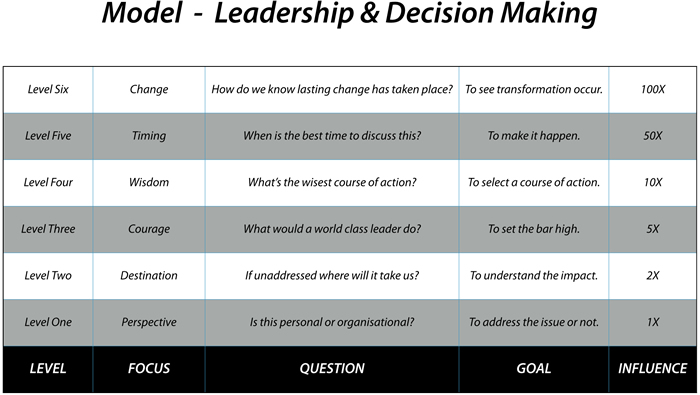Leaders make all manner of decisions. All the time. A critical skill to develop is being able to strategically make fast, well thought out decisions; decisions that have integrity, inclusion and justice built in, AND are able to move the mission forward, deepen the culture and serve your momentum. Somewhat of a challenge isn’t it!? How do you as a leader get more efficient at making decisions? And, more importantly, making the correct decisions more often?
In leadership you are guaranteed to get the decision partly right, partly wrong and partly in need of correction. One framework I’ve found helpful over the years is the ‘The 70% Rule’. The Navy Seals use a decision-making process which simply says: ‘When you have 70% of the information, make the call and keep moving.’ Why? Because moving keeps you safe, makes you less vulnerable and provides opportunity for important adjustments along the way.
I’ll be the first to admit that applying this to the more delicate issue of people, performance, behaviour, culture and direction adds another layer of complexity. However, generally with that much information you have enough of a picture to move forward. Having enough of the picture is the key for decision-making moving forward.
Leaders impact teams in two big ways when it comes to decision-making. The first is when we make decisions decisively and proactively. This creates a confidence that you have the passion and conviction to make sure the team wins. Obviously as a leader you want to be making the best decisions but, at the very least, make decisions! Choose and chart a course of action. Make adjustments along the way; involve the wiser and smarter people around you and keep making decisions!
The second way a leader’s decision-making impacts a team is in the event of a non-decision, or indecisiveness. This can paralyse a team and cause a fall in confidence very quickly. The longer you leave an issue unaddressed, the less confident your team becomes in your ability to make hard calls for the benefit of the organisation you collectively signed up for. A lack of decisiveness can undermine your leadership more rapidly than a bad-decision-done-well. Therefore, learning how to make the hard decision well really matters.
Decision making has six levels. These are outlined in the model below. Let’s understand what each level is and why they matter.

#1. Perspective: Seeing it Right
It’s essential to make the distinction between a personal issue and an organisational one. In every leadership context there will be things and people that impact you negatively. That reality in and of itself isn’t a good enough reason to wade in and ‘make the tough calls’. Being able to see the real issue and discern whether it’s significant to the organisation is a foundational place for leaders to start.
It might bother you but, if it’s inconsequential to the organisation, let it go.
#2. Destination: Landing it Right
Inexorably linked to Level One is the Second Level where you must work out
the implications of confronting a matter. The thing to consider here is: ‘If this matter goes unaddressed, will it move the organisation closer to mission achievement or further away?’ In preparing for leadership and mentoring conversations, I ask myself the question: ‘If I multiplied this person and their behaviour by 100, would we be charging towards mission achievement?’ That kind of hyperbole seems to make the answer obvious.
If it’s moving the organisation away from mission achievement, it’s time to do something about it.
#3. Courage: Handling it Right
In the introduction I point out the price of non-leadership; the cost of no decision. Leaving unhelpful behaviour unaddressed is costly and dangerous to both the organisation and you as a leader. People expect you to lead. People expect you to tackle the tough stuff. How you do that is another matter. None-the-less, doing nothing and expecting a change in the atmosphere will not solve the problem or build confidence in your leadership.
Put yourself in the most helpful environment you can and ask yourself: ‘What would a world class leader do in this circumstance?’ Then create a plan to do that too.
#4. Wisdom: Saying it Right
Continuing in the preparation phase, Level Four invites you to reflect on the quality of the action needing to be taken. As you continue in leadership, do you notice that right and wrong is far less of an issue? People are good. People have positive intentions. People do the best they know how most of the time. It’s rarely an issue of right or wrong and much more an issue of wise and unwise.
Andy Stanley calls it ‘The best question ever’; that is: ‘What’s the wise thing to do right now?’ Uncovering the answer will begin to give you more clarity on how you as the leader need to address the issue at hand. Wisdom is universally applicable and universally available. Wisdom, when applied, is far more likely to serve the issue, the organisation and any people involved.
#5. Timing: Doing it Right
Level Five invites you to work out WHEN you must have this conversation, and HOW you must have it. What is the degree of urgency? When is the best time to have the conversation? What tone is required? What level of formality? Who else needs to be present? The attention must shift from the issue to the person. Think through the best way to have the biggest success.
Often relationships are strengthened by handling these kinds of conversations correctly. At this point your focus must be on the best possible result that can be accomplished by addressing the most important issues at hand.
One of your best strategies is to be honest with the person: ‘Dave, I need to sit down with and discuss __________. When would be a good time to do that?’ Or you could even be as direct as: ‘Dave, when and how should we have a discussion about _________?’
The right conversation at the right time with the right intention will get you the right outcome.
#6. Change: Making it Right
The final Level in making hard decisions relates to being clear and specific around the kind of change both parties agree they need to see. Consider this the application section. It’s where you agree on specifically what needs to be different as a result of the conversation. When you invite the person to suggest and make changes, clarify what these look like and commit to a course of action. In doing this you set the relationship up as one of partnership; not one of dictatorship.
It’s critically important to be clear about exactly what has to change, why and by when. Once you have agreed to commit to these terms you can walk alongside one another, and become more of a coach and cheerleader than the judge and jury.
Follow the six levels of making hard decisions and you’ll dramatically increase your ability to make the tough calls quickly and get them right more often.
People are worth the time.
Your mission is worth the work.
Those that will follow your example are worth the example.




Blueprints for good decision making that are carefully structured and yet flexible enough to be personalised for just about any context #worthreadingandworthsharing
This is solid advice. Printing this.